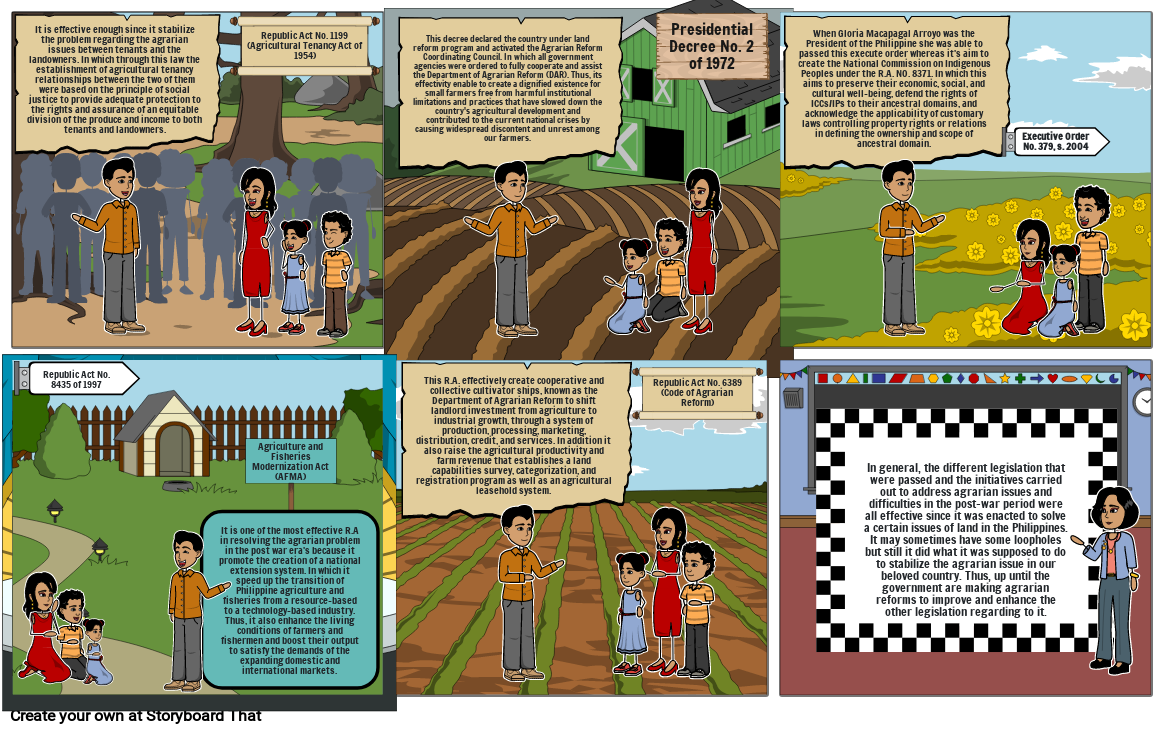Unknown Story

Текст Раскадровки
- It is effective enough since it stabilize the problem regarding the agrarian issues between tenants and the landowners. In which through this law the establishment of agricultural tenancy relationships between the two of them were based on the principle of social justice to provide adequate protection to the rights and assurance of an equitable division of the produce and income to both tenants and landowners.
- Republic Act No. 1199 (Agricultural Tenancy Act of 1954)
- This decree declared the country under land reform program and activated the Agrarian Reform Coordinating Council. In which all government agencies were ordered to fully cooperate and assist the Department of Agrarian Reform (DAR). Thus, its effectivity enable to create a dignified existence for small farmers free from harmful institutional limitations and practices that have slowed down the country's agricultural development and contributed to the current national crises by causing widespread discontent and unrest among our farmers.
- PresidentialDecree No. 2 of 1972
- When Gloria Macapagal Arroyo was the President of the Philippine she was able to passed this execute order whereas it's aim to create the National Commission on Indigenous Peoples under the R.A. NO. 8371. In which this aims to preserve their economic, social, and cultural well-being, defend the rights of ICCs/IPs to their ancestral domains, and acknowledge the applicability of customary laws controlling property rights or relations in defining the ownership and scope of ancestral domain.
- Executive Order No. 379, s. 2004
- Republic Act No. 8435 of 1997
- It is one of the most effective R.A in resolving the agrarian problem in the post war era's because it promote the creation of a national extension system. In which it speed up the transition of Philippine agriculture and fisheries from a resource-based to a technology-based industry. Thus, it also enhance the living conditions of farmers and fishermen and boost their output to satisfy the demands of the expanding domestic and international markets.
- Agriculture and Fisheries Modernization Act (AFMA)
- This R.A. effectively create cooperative and collective cultivator ships, known as the Department of Agrarian Reform to shift landlord investment from agriculture to industrial growth, through a system of production, processing, marketing, distribution, credit, and services. In addition it also raise the agricultural productivity and farm revenue that establishes a land capabilities survey, categorization, and registration program as well as an agricultural leasehold system.
- Republic Act No. 6389 (Code of Agrarian Reform)
- In general, the different legislation that were passed and the initiatives carried out to address agrarian issues and difficulties in the post-war period were all effective since it was enacted to solve a certain issues of land in the Philippines. It may sometimes have some loopholes but still it did what it was supposed to do to stabilize the agrarian issue in our beloved country. Thus, up until the government are making agrarian reforms to improve and enhance the other legislation regarding to it.
Создано более 30 миллионов раскадровок

